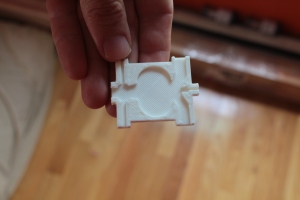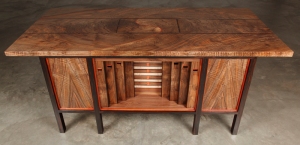Tagged: Arduino
Fluiduino
This blog post is a temperature check for how interested the community would be in an open source, 3d printable, fluidics hardware platform. I want to make sure that this is something that the maker community wants because this isn’t for me, it’s for you. So if you won’t use it, I won’t make it. First, let me wet your appetite by listing cool projects and applications of fluidics, most of which can be printed on a 3d printer and then I’ll tell you how it works and what I want to do with it.
Awesome projects:
Educational. Teach electronics and logic via the fluid/electric analogy which is extremely strong.
3d printable pneumatic stepper motor made from plastic parts only.
Rocket propulsion control systems.
Aircraft flight control systems.
Steam punk steam robot that can function while on fire.
Robust space travel.
Wood wind magic key piano that opens up a trap door with wind.
Programmable digital computer with no electronics.
Programmable fountain with no electronics that you can interact with.
Pulsating shower head. Your shower head already uses fluidics.
Microfluidics, biological control. This could be an open source project in its own right.
Smart meta-materials(speculative).
How it works:
The electric/fluid analogy is very strong. Electrons flowing in a wire is much like water flowing in a pipe and in fact, the two systems follow many of the same laws. A pressure difference is like a voltage, a long narrow tube provides resistance, a membrane is like a capacitor and a coil of pipe is like an inductor. You can send power with electricity and also with fluids(i.e. hydraulic power systems). These are all analog components but the analogy between fluids and electric circuits goes even deeper. Just like with electric circuits, you can make fluidic circuits digital. The principle here is that streams of fluid interact with each other. That is, two streams will divert each other, not pass through, so that you can use a control stream of fluid to divert a power stream. You can use this to build a fluidic amplifier/transistors, logic gates, flip-flops and even a digital computer.

Fluidic amplifier
I’ve taught electronics labs before and let me tell you, electronics are not intuitive to most people. Fluid flow is much more intuitive. One of my main motivations for an open source fluidics project is to make educational kits for high school and college students so that they can gain strong understanding for how electronics work by understanding how the more intuitive fluidic systems work.
Electronics are awesome. I love my computer and I love my Arduino. But there are some applications that semiconductors are bad for. In particular, you can’t light your laptop on fire and expect it to function. Fluidic computers work just fine when on fire, provided the fluidic device is made of something like ceramics or metals and the fluid is something like gas or oil. Indeed, you can make your power stream be rocket thrust, very hot, and use a perpendicular small control stream to divert the power stream, thus being able to steer a rocket! Nasa has a nice blurb about his here.

Rocket control

Fluidic rocket control.
Generally fluidics is practical in harsh conditions. Yet another example is space travel. There are tons of charged particles and other radiation flying around in space that damage semiconductors. Indeed, semiconductors have to be radiation hardened to withstand these harsh conditions. Because fluidics use fluids instead of electrons for their operation, they can be more reliable in such situations.
Fluidics is just plain cool. The number of steam punk applications are endless. You can make a robot that moves and thinks with steam, just steam! There was someone who made a desk that would play notes via a pipe organ when the drawers were opened. If you open the drawers in the right sequence, a trap door would open. It was made entirely from wood with no electronics. Cool huh?
One speculative application that’s on the forefront of science that I’m particularly interested in is digital meta-materials. Digital meta-materials are materials that are made of bits of matter, put together like legos to make something that is functionally more powerful than each individual block. In this case, I’m imagining fabric with a vascular system that responds to temperature and pressure via fluidic logic. I don’t think that 3d printers can beat traditional manufacturing in what traditional manufacturing does well already but I do think that 3d printers can win, hands down, when it comes to complex intricate objects like printing an intricate fluidic vascular system. The philosophy here is that we should be looking for applications of 3d printers that were not possible before.
What I want to do:
I’d like to start an open source fluidics project. Something like Arduino, easy to use, but with fluids. Maybe we could call it the Fluiduino? My primary motivations are educational and inspirations. I want students to have a deep understanding of electronics and I want makers and hobbyists to easily be able to make rocket control systems, steam robots and programmable fountains. What I want from you is feedback as to whether an open source fluidics platform is something you’d be interested in playing with in the future? I’m not doing this for me, I’m doing this for the community as whole so if you’re not interested, I won’t do it. If however, you feel as inspired as I do, I’d love to find people to work with on this project.
-Sebastian Spiegel



